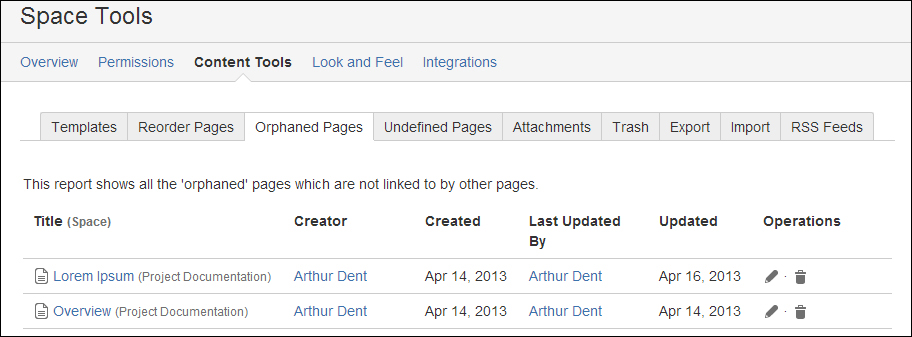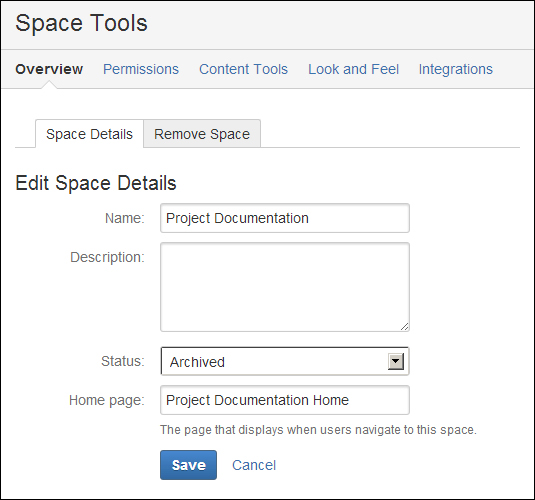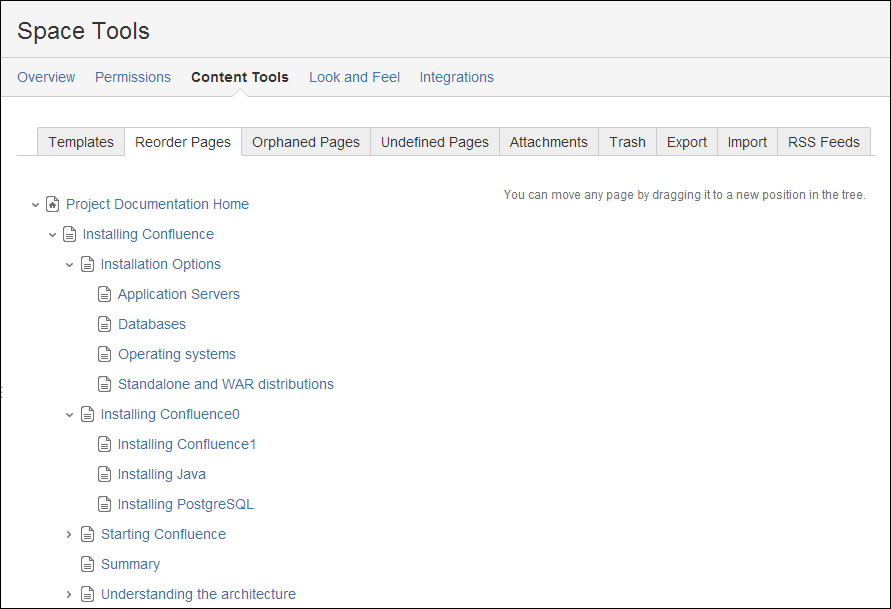Organizing your spaces
In Chapter 3, Creating Content, we learned how to create spaces and pages. Over time, your space will grow and pages might not be in the right order or location. Users might also start complaining that they can't find the page you are referring to. This is the moment your space could use a little organization and cleanup.
Pages within Confluence have a hierarchical structure where other pages can be grouped under a parent page. We refer to this group as page family. Pages within a page family are, by default, ordered in alphabetical order. When you create a new page it will be inserted into the page family in alphabetical order. It is possible to move pages to a different position, automatically changing the order mode to manual. In manual mode, the new page will be placed at the bottom of a page family.
The easiest way to reorder the pages within a space is by using the Reorder Pages view, located in Space Tools. To get to this view:
All pages can be reordered using drag-and-drop. While dragging the page you will see one of the following things happening:
- A thin line will appear between the existing pages. This indicates the potential new position for the page; releasing your mouse button will drop the page at that location.
- A highlighted section will appear over one of more existing pages. This indicates that you can drop the page into the page family. The dropped page will be added to the family according to the sorting order, alphabetical or manual.
Once you have moved one or more pages in a page family, the order is set to manual. To restore this order to alphabetical, perform the following steps:
- Go to the space and choose Space tools on the left sidebar.
- Select Content Tools followed by Reorder Pages.
- Expand the tree to find the page family you want to restore.
- If the page family is manually ordered, there will be an A/Z icon shown next to the parent page.
- Click on the A/Z icon to restore the alphabetical order to that page family.
- Directly after clicking the icon, an undo icon will appear, allowing you to restore the manual order. This undo icon is only available while you are still on the tree view and don't change anything else.
An orphaned page is a page without a parent page or any incoming links. An orphaned page does not appear in any navigation, so users have to know of its existence to be able to search for it. This means that if you have content on an orphaned page, it is very unlikely that people will find it using the natural course of navigation. An orphaned page can be found using search.
Orphaned pages can arise when you are deleting a parent page. All child pages of the deleted parent page will be moved to the root of the space. From that moment the child page has become an orphaned page.
Especially in large spaces, it is difficult to keep track of orphaned pages. Confluence allows you to view all orphaned pages in a space so that you can reorganize or remove them.
To view the orphaned pages, perform the following steps:
- Go to the space and choose Space tools on the left sidebar.
- Select Content Tools followed by Orphaned Pages.
From the Orphaned Pages screen you can edit or delete the page. If you want to move the page and give it a parent page, it is easier to use the Reorder Pages feature discussed earlier. The alternative is to go to Tools | Move from the page in viewing mode, with the advantage that you are able to move the page to another space.

Tip
Orphaned pages aren't necessarily bad
It's not uncommon to have one or more orphaned pages being used as placeholders for attachments or information that is used on many other pages. With the "include" macro, these orphaned pages can be included in those pages. If then, the information changes, you only have to update one page.
Some spaces might contain information that is not relevant anymore. For example, when you use Confluence to write a user documentation and have a space per product version, or a project is finished and the space is no longer needed.
Archiving a space will keep the content available in Confluence but it will be less visible than before. If a space is archived:
- The pages and other content do not appear in the suggestion list when using the Confluence search box.
- The pages and other content do not appear in any search results unless it is specified to also include archived spaces.
- The space isn't listed on the dashboard.
- Any updates to the space's content will not appear in the various activity streams.
- The space, pages, and other content will not appear in any of the drop-down menus in Confluence.
- The archived space will not appear in the general space list in the space directory. The space will be listed on the "archived spaces" tab and categories determined by the space labels.
While a space is archived the following functions will remain available:
- Users will be able to view the content as usual and any bookmarked URL will still work
- Users will be able to edit the content, provided they have the permissions to do so
- Any feeds, watches, or notifications will remain active
To archive a space, perform the following steps:
- Go to the space and choose Space Tools on the left sidebar.
- Select Overview to navigate to the space details page.
- Select Edit Space Details.
- Choose Archived from the status drop-down menu.
- Click on Save as shown in the following screenshot:

If your Confluence installation is open to the public, archived spaces will still be indexed and found via search engines such as Google.

